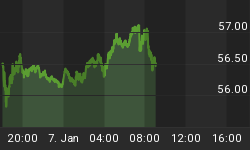10:00 am US Jan Factory Orders (exp -5.5%, prev 1.1%) 10:00 am CAN Feb Ivey PMI (exp 58.2, prev 54.1)
The greenback's mountain remains tamed by the rising euro on the heels of Thursday's post- ECB conference rally, after the central bank described rates as accommodative, and forecasted inflation persisting below the Bank's preferred target of close to 2.0%.
EURUSD breaks above 200 day MA for first time in 4 weeks
The euro comes out on top after last week's hawkish ECB address and relatively cautious remarks from Japan's govt officials, boosting the euro to 4-week highs against the dollar and 3-week highs against the yen. EURJPY is making its fifth daily gain versus the Japanese currency, the longest winning streak since July of last year.
Some ECB observers have pointed the ECB's omission of the word "vigilant" in last week's rate decision implying a less hawkish stance against inflation, but we deem an the omission as a deliberate move to avoid excessive euro gains, especially in a period of emerging dollar uncertainty.
Friday's stronger than expected US Feb services ISM may have stabilized the dollar from its losses of earlier in the week, but did not prevent the currency from ending the week lower against the majors. The euro's highest close since Feb 2 suggests further upside this week and possibly taking out the 200-day MA.
The euro could be further propped by a double boost of industrial production data in France and Germany with the former likely showing a 1% rise in January following December's 0.5% decline and the latter seen rising 0.5 % after a 0.3% drop.
Euro bullishness against the dollar soared 82% to 18,402 in the week ending on Tuesday, posting the first increase in 5 weeks. The rising bullishness occurred ahead of this week's ECB rate hike, which did not fail in propping the euro thanks to JC Trichet's conference.

EURUSD's technical stance has intensified on the upside as it not only breached broke above the 200-day MA but also broke the 50% retracement of the move from the year high (1.2322) to the year's low (1.1877). We see further gains today topping at 1.2110. A break above it is seen capped at the 61.8% retracement of the said move at 1.2133. Support stands at the 200 day MA of 1.2050, backed by 1.2020.
Yen struggles as Govt says "not too fast"
The yen continues to struggle across the board after Prime Minister Junichiro Koizumi reiterated today that he wants the Bank of Japan to make a "careful decision' when deciding to end its anti-deflation quantitative monetary policy at its meeting this week. Separately, a ccording to The Nihon Keizai Shimbun, the Bank of Japan plans to hold the balance of its current account deposits available for commercial banks and financial institutions at a minimum of no less than 10 trillion yen for some time once it ends its quantitative easing policy. Currently, the BoJ injects 30-35 trillion yen worth of liquidity as part of its ultra easing policy. Rather than making the potentially market destabilizing move of slashing liquidity from the current range of 30-35 trln yen to the more normal 6 trillion yen mark in one step, the Bank will gradually lower the range for a few months before settling at the 10 trln yen mark so as not to trigger a sudden shortage of funds for commercial banks.
The yen sell-off started last Friday after speculation of a near-term shift in monetary policy was tempered by cautious remarks from Govt officials on Friday. Fin Min Tanigaki said Japan is still experiencing mild deflation despite the Feb 0.5% CPI rise showing its highest level in 8 years. The fact that the Fin minister said the government and the central bank must collaborate in fighting inflation suggests that govt officials will continue showing their hand in the voting of the BoJ policy board and influence the majority decision.
Some market observers are interpreting the latest reminders from govt officials as a red light against a policy shift at the March 8-9 meeting. But we expect the Bank of Japan to opt for reducing liquidity this week from the current 30-35 trln yen range to 25-30 trn yen. Such a modest tightening in liquidity would be considered as a viable compromise between the BoJ doves and the govt hawks.
In the futures market, yen bearishness was cut by 68% against the dollar to 22,821 contracts in the week ending last Tuesday, posting the first decline in 6 weeks as traders unwound their yen shorts ahead of this week's CPI figures.

We also see the yen a victim of any ongoing oil rally resulting from the International Atomic Energy Agency's anticipated report on Iran's nuclear facilities. The report is expected to refer Iran to the UN Security Council, which could vote to impose economic and political sanctions on the Islamic republic.
USDJPY technicals show a more convincing improvement in the short term (4-hour chart) than in the medium term (daily chart) as we see the dollar hitting interim target of 117.45-50, just above the 100-day MA. Further upside capped at 117.90. Support climbs at 116.70, backed by 116.
This week's FX highlights include the Bank of Canada's expected rate hike, the Bank of Japan's expected tightening, the US January trade deficit and the US January nonfarm payrolls. The Bank of Canada is expected to raise its cash rate by 25 basis to 3.75% on Tuesday, while the Reserve Bank of Australia is seen on hold at 5.50% for the 12th consecutive month on Wednesday evening -NYT. We expect the Bank of Japan to reduce its quantitative from 30-35 trln yen to 20-23 trln yen at its March 8-9 meeting. The Bank of England is expected to announce remaining on hold at 4.50% this Thursday.
















